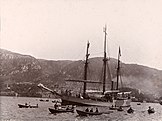Portal:Norway/Selected article/15
Nansen's Fram expedition was an 1893–1896 attempt by the Norwegian explorer Fridtjof Nansen to reach the geographical North Pole by harnessing the natural east–west current of the Arctic Ocean. In the face of much discouragement from other polar explorers Nansen took his ship Fram to the New Siberian Islands in the eastern Arctic Ocean, froze her into the pack ice, and waited for the drift to carry her towards the pole. Impatient with the slow speed and erratic character of the drift, after 18 months Nansen and a chosen companion, Hjalmar Johansen, left the ship with a team of dogs and sledges and made for the pole. They did not reach it, but they achieved a record Farthest North latitude before a long retreat to Franz Josef Land. Meanwhile Fram continued to drift westward, finally emerging in the North Atlantic Ocean. The ship was rarely threatened during her long imprisonment, and emerged unscathed after three years. The scientific observations carried out during this period contributed significantly to the new discipline of oceanography, which subsequently became the main focus of Nansen's scientific work. Fram's drift and Nansen's sledge journey proved conclusively that there were no significant land masses between the Eurasian continents and the North Pole, and confirmed the general character of the north polar region as a deep, ice-covered sea. (Full article...)

